The hamstrings are one of the most important muscle groups in the leg. Hamstrings help us sprint faster, jump higher, and prevent knee and hip injuries. They also help to improve sports performance.
We need to work on our hamstring muscles to make them bigger and stronger, but it can be hard to do it with just free weights.
Here, the gym machines play an important role in building bigger and stronger hamstrings.
Gym machines offer several advantages over free weights for hamstring training. Machines allow you to isolate and work all three hamstring muscles to stimulate greater muscle growth.
This blog will discuss the following:
- Top gym machines for building bigger hamstrings.
- How to perform hamstring exercises with proper form.
- Benefits of using gym machines for hamstring workouts.
- A complete workout program
Let’s dive in!
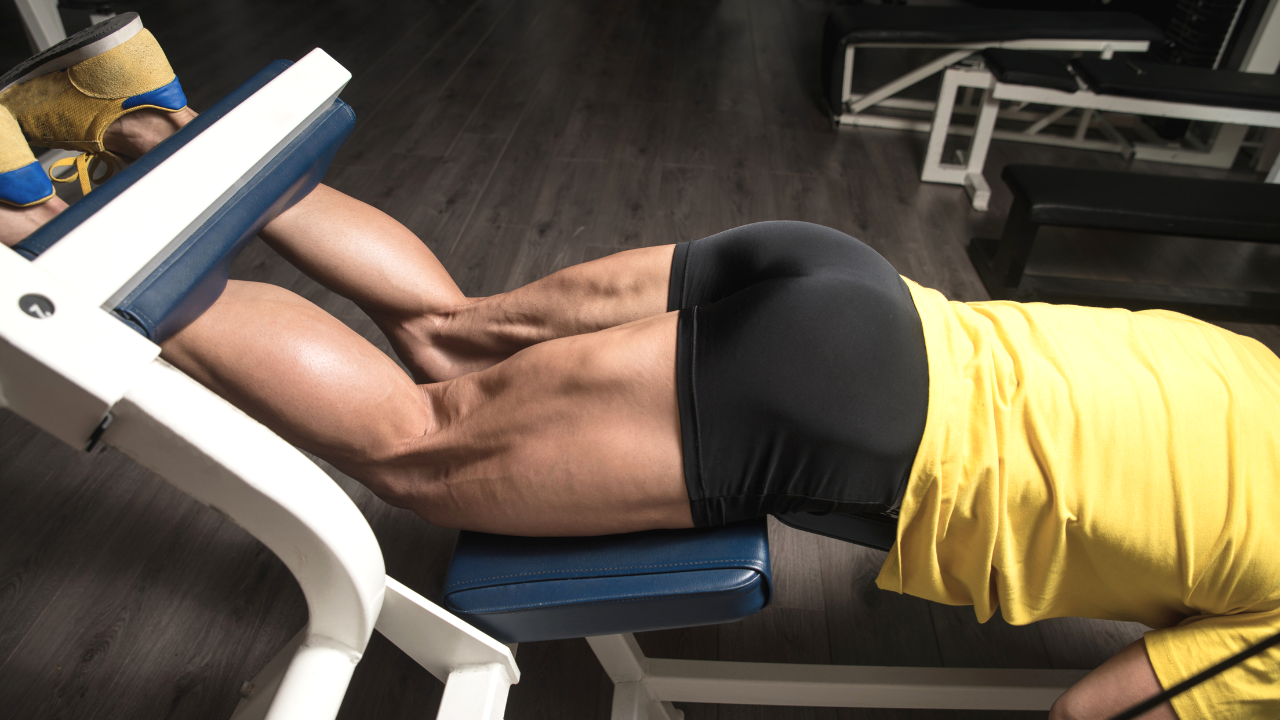
- 9 Best Machines For Hamstring Workouts
- 1. Leg Curl Machine
- 2. Glute And Ham Raise Machine
- 3. Hyperextension Bench
- 4. Reverse Hyperextension
- 5. Smith Machine For Hamstring Workouts
- 6. Cable Machine For Hamstring Exercises
- 7 Leg Press Machine
- 8. Seated Leg Curl Machine
- 9. Standing Hamstring Curl Machine
- Conclusion
- Why Use Hamstring Machines?
9 Best Machines For Hamstring Workouts
While deadlifts are a staple for building the hamstrings, adding strength machines to your program is important to make your hamstrings bigger and more decisive.
The top 9 workout machines to add for a complete hamstring workout.
1. Leg Curl Machine
The leg curl machine is common in gyms and helps strengthen your hamstring muscles. It also works the calf and glute muscles.
It typically consists of a padded seat with an adjustable backrest and a lever connected to a weight stack or cable system.
Unlike some free-weight exercises, leg curls minimize stress on the lower back.
Muscles Worked
- The leg curl machine primarily targets the hamstring muscles.
- Additionally, it engages the calf and glutes to a certain extent.
Different positions of the toes work different hamstring muscles.
- Pointing your toes straight targets all three hamstring muscles.
- Pointing the toes inward emphasizes the inner hamstrings (semimembranosus and semitendinosus),
- Pointing the toes outward focuses effort on the outer hamstrings (biceps femoris).
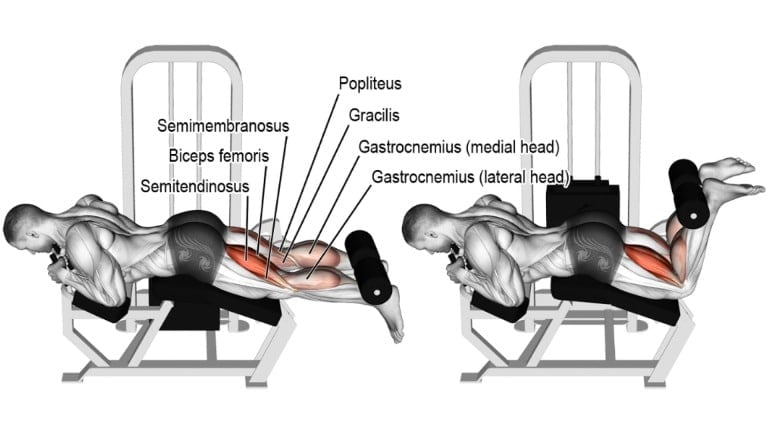
How To Use It
- Lie face down on the machine, with your knees just beyond the edge of the bench.
- Position your ankles securely under the padded lever.
- Grasp the handles for stability and to keep your upper body firmly positioned on the bench.
- Exhale as you flex your knees, lifting the padded lever toward your glutes. Hold the contraction briefly.
- Inhale as you extend your legs back to the starting position.
- Start with a weight that allows 10–12 reps.
2. Glute And Ham Raise Machine
The Glute and Ham Raise Machine, also called the Glute-Ham Developer (GHD), helps strengthen posterior chain muscles, especially your glutes and hamstrings.
That means that the glutes get involved as well (as the name of the exercise would imply), along with the spinal erectors.
If your gym has this apparatus, you should add it to your hamstring exercises arsenal, which helps to build mass and strength in your legs.
Muscles Worked
- The primary muscles targeted by the Glute and Ham Raise Machine include the gluteus maximus (glutes) and the hamstrings.
- Additionally, it engages the erector spinae in the lower back and the calves to some extent.

How To Use It
- Ensure the footplate on the GHD is far enough back so that your knees rest at the bottom of the pad.
- Your feet should firmly touch the footplate, and the bottom of your quads should rest on the pad with your body upright.
- Ensure your back is flat, your legs are slightly less than hip-width, and your torso is upright.
- Bring your arms across your chest.
- Push your toes into the plate and extend your knees. This will move your body forward until you are parallel to the floor.
- To get back up, bend your knees and move your upper body back to where you started.
3. Hyperextension Bench
The Hyperextension Bench is an essential piece of gym equipment specifically designed to target the muscles in your erector spine and glutes. This machine is often found in both commercial and home gyms. It aims to strengthen your back and glutes and improve your posture.
If you’re new to exercise or have an injury, the machine is a safer option than free weights because it allows you to move your body in a controlled way. It’s a simple exercise to learn, so you can start using it right away.
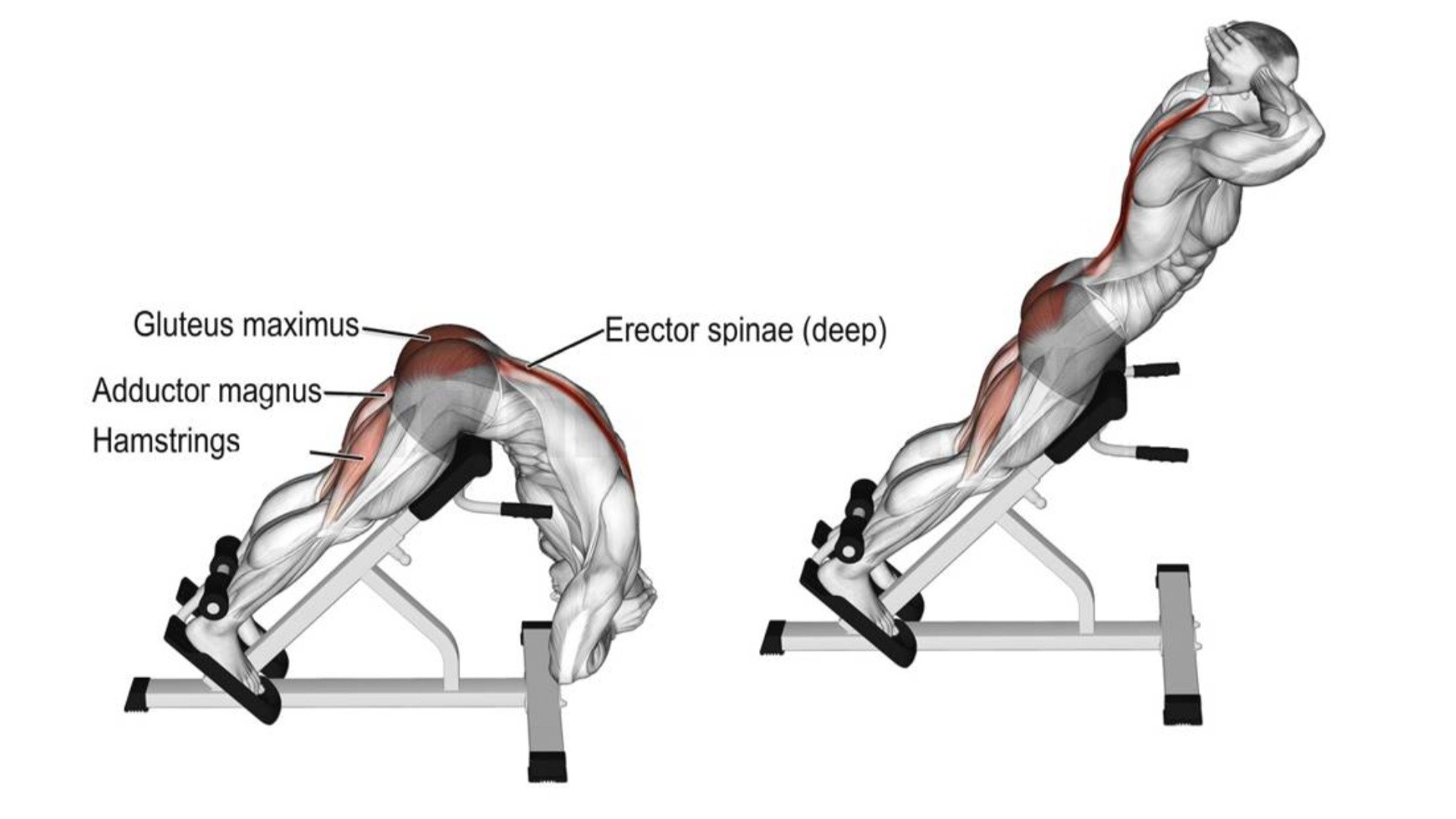
How To Use It
- Lie face down on the back extension machine. Adjust the pad so that it supports your thighs and hips.
- Bend your knees slightly and secure your feet under the footplates. Keep your knees in line with your hips.
- Cross your arms over your chest or place your hands gently at the side of your head.
- Exhale and raise your upper body until your shoulders, spine, and hips are in line.
- Inhale as you lower yourself back to the starting position, ensuring a controlled movement.
- Aim for 3 sets of 10–15 reps, depending on your comfort and fitness level.
4. Reverse Hyperextension
Reverse hyperextension is a multipurpose workout that can be used to strengthen the hamstrings, glutes, and hip flexors. It is a low-impact exercise that is good for people with a weak back.
If you’re new, you may start with just the weight of your legs or add minimal weight and increase as you become more comfortable.
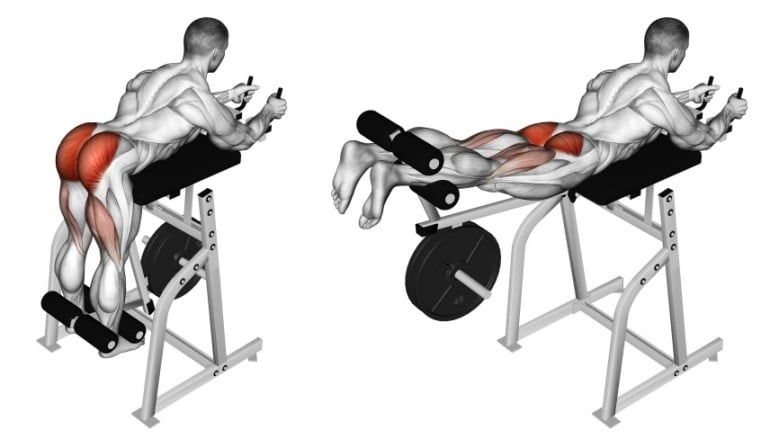
How To Use It
- Lie facing downwards on the hyperextension machine with your upper body and stomach on the bench, and secure your legs under the rollers.
- Allow your legs to hang towards the floor and grip the handles.
- Exhale and lift your legs by contracting your glutes and lower back muscles.
- Your legs should form a straight line with your torso at the movement’s top.
- Lower your legs back to the starting position slowly and inhale as you do it.
- Aim for two or three sets of 8 to 15 reps.
5. Smith Machine For Hamstring Workouts
A Smith Machine consists of a barbell fixed within steel rails, allowing only vertical movement. This guided path provides stability and control, making it a useful tool for both beginners and experienced lifters.
The machine’s stability helps you maintain proper form and reduce the risk of injury. This is why the Smith machine is stable and safe for different movements.
It is often used for various exercises, such as squats and deadlifts. The exercises chosen can influence the muscles targeted by hamstring workouts on the Smith Machine.
- Smith Machine Stiff-Legged Deadlifts: Isolate your hamstrings with it.
- Smith Machine Back Extensions: Target the hamstrings isometrically in a stretched position.
- Smith Machine Glute Ham Raises: Hits the hamstrings and glutes eccentrically to build strength and size.
- Smith Machine Romanian Deadlifts (RDLs): Similar to stiff-legged deadlifts, RDLs on the Smith Machine keep your focus on the hamstrings and glutes.
- Smith Machine Sumo Deadlifts: Widen your stance to emphasize hamstring and glute activation.
- Smith Machine Single Leg Deadlifts: Focus on each hamstring individually for complete development.
- Smith Machine Good Mornings: This exercise emphasizes the hamstrings and lower back.
- Smith Machine Hip Thrusts: Provides a stable platform to overload the contracted hamstring position.
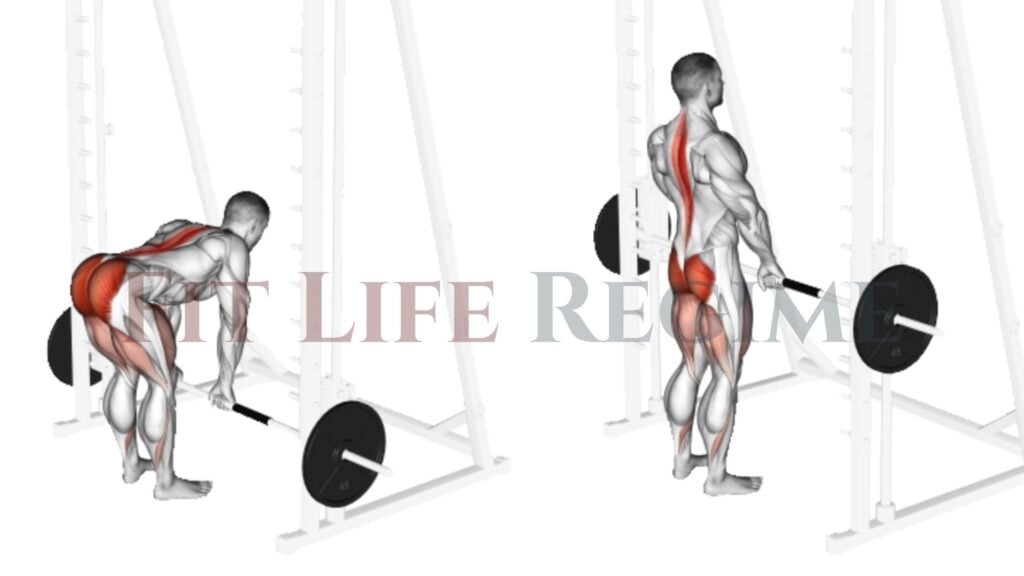
How To Do Smith Stiff-Legged Deadlift
- Place the Smith bar on your thigh and stand with your feet about shoulder-width apart.
- Grab the bar with an overhand, shoulder-width grip.
- Keep your back straight, head up, and hips low, and lift the barbell into a standing position.
- Flex your knees a little, push your hips backward, and slowly lower the barbell down the front of your legs.
- Lower the bar down as far as your hamstrings will let you comfortably.
- Engage the hamstrings and begin to raise the bar straight back up.
Know More: 12 Most Effective Smith Machine Leg Workout & Exercises
6. Cable Machine For Hamstring Exercises
The cable machine is a versatile tool that effectively targets and strengthens the hamstring muscles. Unlike traditional free weights, it maintains consistent tension, allowing for precise isolation and engagement of the hamstrings.
Equipped with two adjustable pulleys, the cable machine offers various angles and attachments to work all three hamstring muscles.
Here are some effective hamstring exercises you can perform on this machine:
- Cable Lying Leg Curl: Isolate and target the hamstrings with this effective movement.
- Cable Seated Leg Curl: Hit the hamstrings from multiple angles for complete development.
- Cable Pull-Through: This popular exercise promotes hams and glute strength.
- Cable Stiff-Leg Deadlift: Target the hamstrings while emphasizing the stretch at the bottom.
- Cable Single Leg Deadlift: Focus on each hamstring individually for balance and symmetry.
- Cable Good Morning: Develop hamstring strength and stability in a bent position.
- Cable Hip Hinge: Mimic the function of a Romanian deadlift to build hamstring mass.
- Cable Lunges (Forward or Reverse): These primarily work your quads and secondarily work the hamstring during reverse movement.
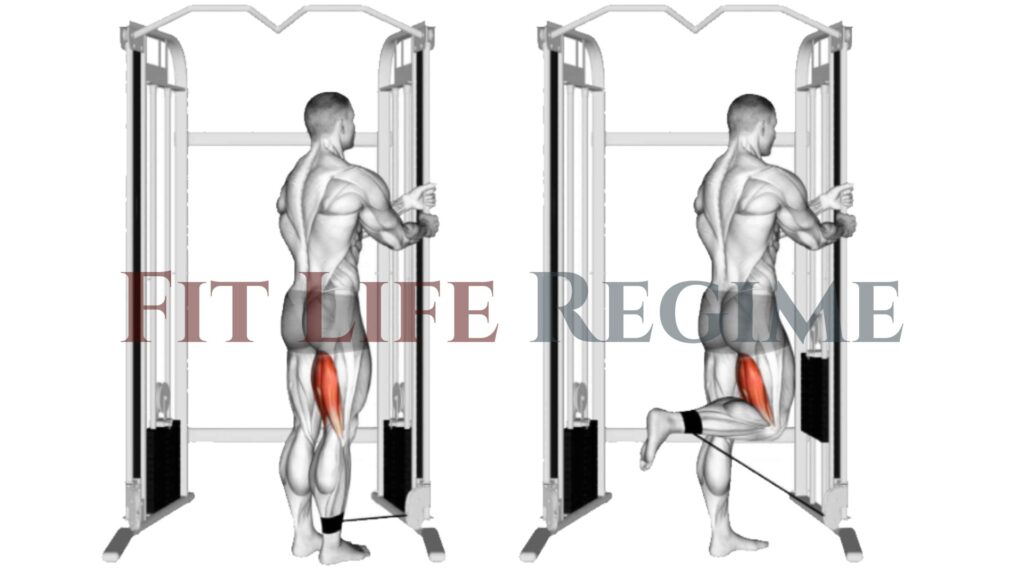
How To Do Cable Standing Leg Curl
- Stand next to a machine that has a floor-level pulley. Attach the foot harness to a low pulley.
- With a foot harness on one ankle, grasp the support bar with both hands and step back with the other foot.
- The attached foot is slightly off the floor.
- Pull the cable attachment back by flexing the knee until the knee is fully bent.
- Return by straightening the knee to the original position and repeat.
- Continue with the opposite leg.
7 Leg Press Machine
The leg press machine typically consists of a seat with a backrest and a platform where the feet are placed.
It targets multiple leg muscles, including the quadriceps, hamstrings, glutes, and calves.
The machine has an adjustable seat and footplate to accommodate different users. By altering your foot placement, you can emphasize different muscle groups.
The leg press is a safe and steady exercise that is good for people who are new to doing leg exercises.
A study has found that the gluteus Maximus and hamstring activity was greater during the high leg press than the variations.
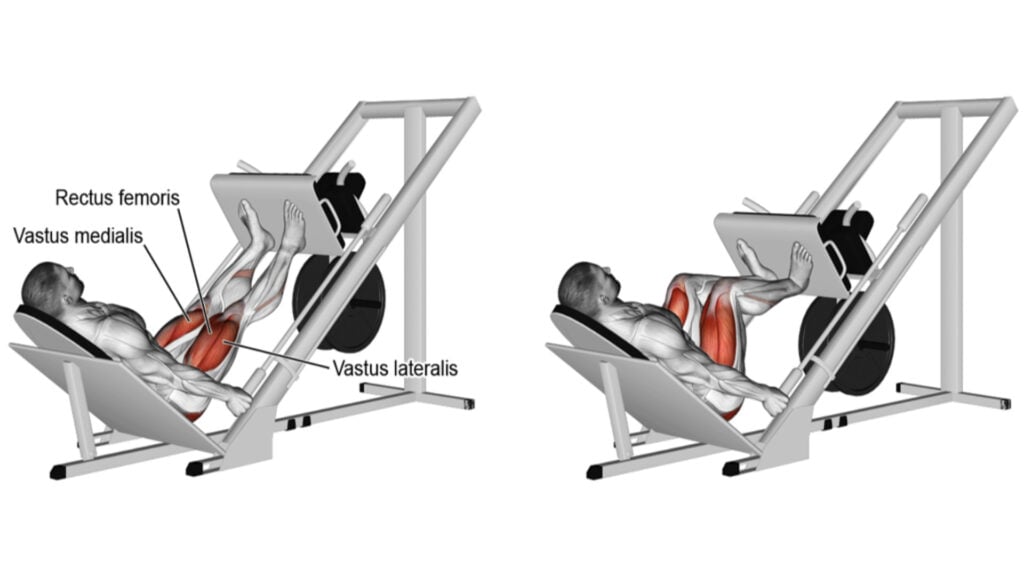
How to Use the Leg Press
- Adjust the seat position so your back is fully supported and your knees are bent at roughly a 90-degree angle when your feet are flat on the footplate.
- Position your feet about shoulder-width apart on the footplate. Experiment with:
- High Feet Leg Press for Hamstrings and Glutes.
- Low Feet Leg Press for Quadriceps.
- Wide Stance Leg Press for Inner quadriceps.
- Narrow Stance Leg Press for Outer quadriceps.
- Start with a lighter weight if you’re a beginner. Ensure you can complete full repetitions with proper form.
- Disengage the safety locks and press the footplate away from your body using your legs.
- Extend your legs without locking your knees at the top of the movement.
- Return the footplate slowly and with control to the starting position (focus on the eccentric/lowering phase).
8. Seated Leg Curl Machine
The Seated Leg Curl Machine typically consists of a seat with a padded leg rest and a weighted stack. The user sits with their legs extended and places their lower legs against the padded leg rest.
The stable, seated position prevents excessive strain on the lower back compared to free weights. It provides focused hamstring work with minimal involvement from other muscle groups.
You can also perform seated leg curls unilaterally. Decrease the weight, let one leg rest, and complete each rep with the same form as the standard seated hamstring curls.
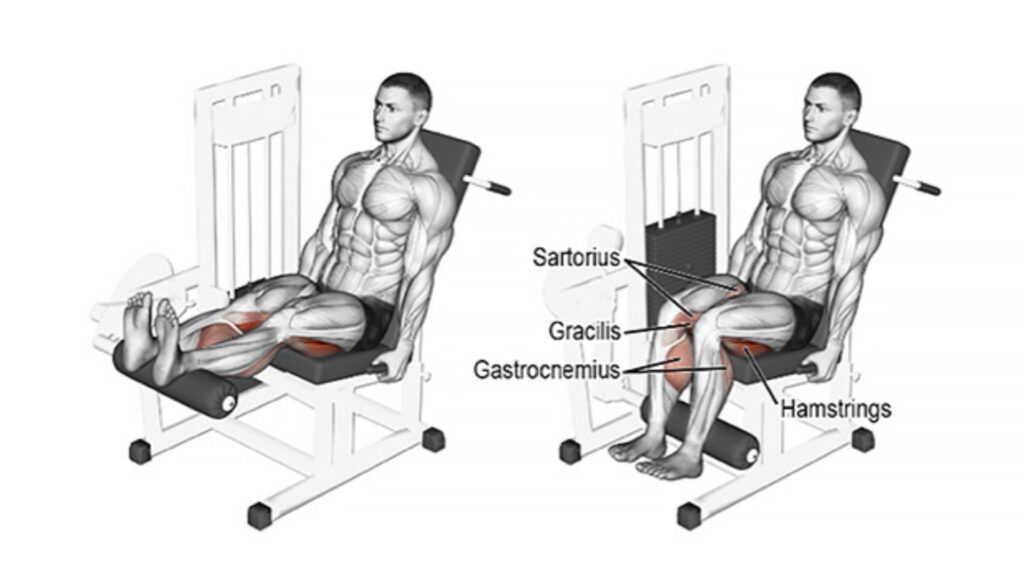
How to Use the Seated Leg Curl Machine
- Adjust the seat height so that the padded leg rest is aligned with your ankle joint when seated.
- Choose a weight that is challenging but allows you to maintain good form.
- Sit up straight on the machine, knees bent, and feet flat on the floor.
- Hold the handles on the side for stability.
- Contract your hamstrings and curl the lever downward.
- Slowly lower the lever back to the starting position, resisting the weight on the way down (eccentric phase).
9. Standing Hamstring Curl Machine
The standing hamstring curl machine is a piece of gym equipment designed to target your hamstrings in a standing position. It strengthens the hamstrings, buttocks, and calves.
Much like the seated version, it provides focused hamstring work, minimizing the involvement of other leg muscles.
Many machines allow you to curl one leg at a time, improving muscle balance and addressing potential strength imbalances.
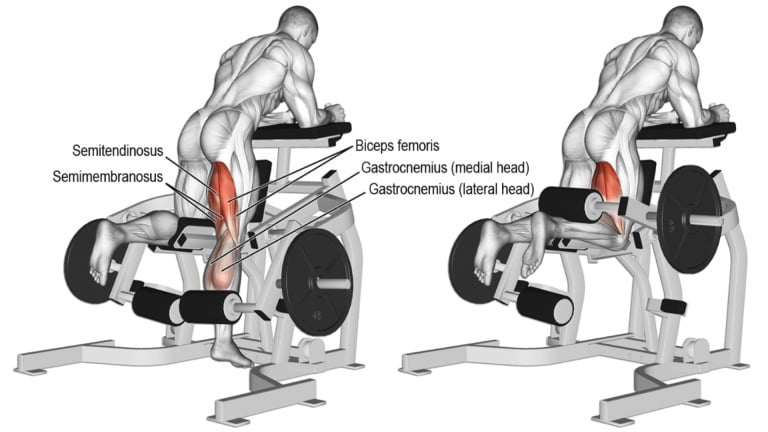
How to Use the Standing Hamstring Curl Machine
- Position the lever so it rests comfortably against the back of your calf, just above your ankle.
- Select an appropriate starting weight. B
- Stand on the platform with your feet hip-width apart.
- Slightly bend the knee of the working leg and grasp the handles for support (if available).
- Curl your working leg upward towards your glutes, contracting your hamstrings.
- Slowly lower your leg back to the starting position.
- Repeat the same process on the other leg.
- Be sure to maintain equal work on both sides.
Conclusion
Gym machines can be a great way to build bigger, stronger hamstrings and reduce injury risk.
Some of the most popular gym machines for hamstring workouts include the lying and the seated leg curl machine.
You can also use a Romanian deadlift machine, glute ham raise machine, and cable machines to strengthen your hamstrings.
These machines allow you to overload your hamstrings safely with heavier weights than free weights. They also isolate the hamstrings for targeted development.
So, the next time you’re at the gym, utilize these powerful tools as part of a comprehensive program for building impressive hamstring mass and strength.
Why Use Hamstring Machines?
Hamstring machines offer advantages over free-weight exercises like squats and deadlifts for targeting your hamstrings:
- Hamstring machines work the hamstring muscles better than free-weight exercises like deadlifts and good mornings.
- With the use of machines, you can isolate the hamstring muscles with minimal involvement from other leg muscles.
- Hamstring machines are good for people who are new to strength training because they move slowly and provide support.
- Specific hamstring machines are designed to focus on different areas of your hamstrings.
- Having stronger hamstrings can help reduce the risk of strain or injury in your knees and lower back.
- Most gyms have dedicated hamstring machines that help you build bigger legs.

Manish brings over 10 years of hands-on experience in weight lifting and fat loss to fitness coaching. He specializes in gym-based training and has a lot of knowledge about exercise, lifting technique, biomechanics, and more.
Through “Fit Life Regime,” he generously shares the insights he’s gained over a decade in the field. His goal is to equip others with the knowledge to start their own fitness journey.
